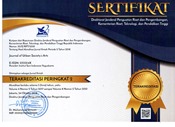Ephemeral Architecture as Socio-spatial Practices in Bintaro’s Modern Market Public Space
Abstract
Ephemeral Architecture as Socio-spatial Practices in Bintaro’s Modern market Public Space. Ephemeral Architecture questions about the idea of permanence on the way we produce architecture. The term ephemeral defines as something temporary, interchangeable, and adaptive. Architecture’s vision should no longer has to be monumental or eternal, but it must be designed to became adaptive in uncertain conditions. This research offers new perspective on how architecture built from the event. The research methods, conducted in practices-based research through a series of workshop and forum group discussion in experimental architecture forum- Critical Context 3.0, 2019, conducted by LabTanya. The participants explore the notion of ephemerality on everyday design in modern market Bintaro, Jakarta by adopting phenomenology perspective in architecture. This phenomenology perspective transcribes in a way a phenomenon observes in term of body, gestures, movement in relation to time and social consent produced these momentarily space. The modern market (as a case study) gives context on how this place are became a melting point of several functions, time and places. This research finds that there are several strategies on how the tenant are inhabiting the space in performative and temporals way to resolve the spatial limitations.
Arsitektur Efemera sebagai Praktek Ruang Sosial Pada Ruang Publik Pasar Modern Bintaro. Arsitektur Efemera, mempertanyakan tentang gagasan keabadian dalam cara mendesain arsitektur. Istilah efemera atau sesaat, didefinisikan sebagai sesuatu yang sementara, selalu mengalami transformasi, dan adaptif. Visi arsitektur tidak lagi harus monumental atau abadi, tetapi harus dirancang untuk menjadi adaptif dalam kondisi konteks lingkungan yang dinamis. Penelitian ini menawarkan perspektif baru tentang bagaimana arsitektur dibangun dari sebuah peristiwa. Metode penelitian, berbasis praktik melalui serangkaian lokakarya dan forum diskusi yang digagas pada forum arsitektur eksperimental- Critical Context 3.0, 2019, oleh LabTanya, Jakarta. Para peserta mengeksplorasi gagasan arsitektur efemera/sesaat pada desain keseharian di pasar modern Bintaro, Jakarta melalui perspektif fenomenologi. Perspektif ini, menginvestigasi bagaimana tubuh, gerak dan waktu selalu berkaitan dengan konteks sosial suatu tempat. Pasar modern (sebagai studi kasus) memberikan konteks bagaimana tempat ini merupakan titik lebur dari beberapa fungsi, kaya akan ruang-ruang sementara (spatio temporal). Hasil penelitian ini menemukan beberapa strategi ruang adaptif, yang dilakukan oleh para penyewa pasar, dalam mengatasi keterbatasan ruang.
Keywords
Full Text:
PDFReferences
Baudrillard, J. (1981). Simulacra and Simulation by Jean Baudrillard, Sheila Faria Glaser (z-lib.org). University of Michigan Press.
Cairns, S., & Jacobs, J. M. (2014). Building Must Die. The MIT Press.
Debord, G. (1983). Society of the spectacle. Black & Red.
De Certeau, M. (1984). The Practice of Everday Live. University of California.
Heidegger, Martin. (1962). Being and Time. Eastford: Martino Book and Publishing
Karandinou, A. (2013). No Matter: theories and Practices of the Ephemeral in Architecture. Ashgate Publishing Company.
Kassem, A. (2019). Performative Interiors: Terminological and Theoretical Reflections on the Term ‘Performative.’ Interiority, 2(1), 95–106. https://doi.org/10.7454/in.v2i1.51
Kleine, H. (2017). The Drama of Space (1st edition). Birkhauser.
Kusno, A. (2020). Middling urbanism: the megacity and the kampung. Urban Geography, 41(7), 954–970. https://doi.org/10.1080/02723638.2019.1688535
Merleau-Ponty, M. (2005). Phenomenology of Perception. Publisher: Routledge, London & New York
Moran D.(2000). Introduction to phenomenology, UK: Routledge
Pallasmaa J. (2007). The Eyes of the Skin, UK: John Wiley & Sons
Holl S.(1996). Intertwining, Princeton Architectural Press: New York
Raef, K., & Gorgi, F. (2019). Revisionist Architecture. Journal of Urban Society’s Arts, 6(2), 81–86.
Rossi, A. (1976). The Architecture and Art of the Analogous City. https://www.researchgate.net/publication/333429672
Rossi, A. (1982). The Architecture of the City. The MIT Press.
Seamon D. (2003). Phenomenology, Place, Environment and Architecture: Literature review, Trans: Sema Serim, TOL Journal of Architecture Culture
Tschumi, B. (1994). Architecture and disjunction. MIT Press.
Turner, C. (2015). Dramaturgy and Architecture: Theatre, Utopia and the Built Environment. Palgrave Macmillan. https://doi.org/10.1057/978113731714
Valibeigi, M., & Ashuri, F. (2020). Deconstruction and Fractalization of Urban Identity. Journal of Urban Society’s Arts, 7(1), 1–8.
Venturi, Robert., Scott Brown, D., & Izenour, S. (1977). Learning from Las Vegas : the forgotten symbolism of architectural form. MIT Press.
Yates, F. Amelia. (1966). The Art of Memory. Antony Rowe Ltd.
Yudistira, F., Yatmo, Y. A., & Atmodiwirjo, P. (2019). From rigidity to ephemerality: Architecture as a socio-spatial assemblage of heterogeneous components. A/Z ITU Journal of the Faculty of Architecture, 16(3), 115–129. https://doi.org/10.5505/itujfa.2019.14890
DOI: https://doi.org/10.24821/jousa.v9i1.6107
Article Metrics
Abstract view : 0 timesPDF - 0 times
Refbacks
- There are currently no refbacks.

This work is licensed under a Creative Commons Attribution 4.0 International License. ISSN 2355-2131 (print) | ISSN 2355-214X (online).






